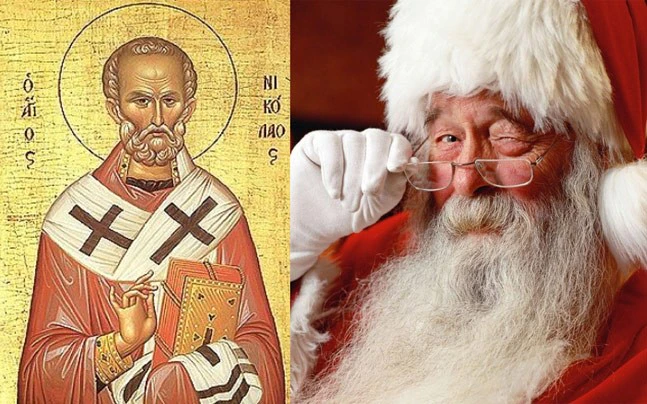In many parts of Europe, 6 December is an important day. It is St. Nicholas Day, a day where children are given special cookies, sweets and gifts. Saint Nicholas was born circa 280 in Patara, Lycia, an area that is part of present-day Turkey. Over the centuries the legendary St. Nicholas was merged with similar cultural and religious figures. Hence today, the figure and traditions vary from country to country. (If you would like to read more on the history of St. Nicholas, scroll down to the end.)
Four LI classes (Czech, French, German and Polish) celebrated their own tradition and worked together to discover how it is celebrated in other European countries.
The French class
This project allowed Charlotte to read the full story
of Saint Nicolas. She <p><a href=”https://www.8xscore.online/th>ผล บอล ส เปอร์</a></p>realised that this celebration also existed in France. Saint Nicolas is mainly celebrated in two Eastern French Regions: La Lorraine and L’alsace. After making a drawing and writing a text about the Saint Nicolas Celebration in France, she played the game of identifying the differences between Nicolas in Poland, Czech Republic and Germany and she noticed that Nicolas distributes sweets to<p><a href=”https://www.8xscore.online/th>วอลเลย์บอล เวิร์ค พอยท์ 23 สด ตอน นี้</a></p> kids who had been nice throughout the year.
French Teacher
The Czech class
The Czech students watched<p><a href=”https://www.8xscore.online/th>ตารางบอลวันนี้ ถ่ายทอดสด</a></p> a nice, <p><a href=”https://www.8xscore.online/th>บอล วัน นี้ ไทย</a></p>animated video on the topic. They also read poems about St. Nicholas and learned some of these off by heart. The pupils drew nice pictures and made masks of St. Nicholas, the Devil and Angel, because these three always arrive together. They know that the St. Nicholas tradition is very old and all the children in the Czech Republic look forward to it. They know that the children receive treats from Nicholas or coal and potatoes from the devil. They learned that it is connected to Advent. They have also learned about another figure, Saint Martin, who comes before Saint Nicholas. He brings the first snow to the Czech Republic. Josef wrote a beautiful description of a very old painting using compound sentences.
Czech Teacer
The German class
Linda likes St. Nicholas’ Day and<p><a href=”https://www.sofocapacitor.com/”>คะแนน ผล บอล สด 888</a></p> she prepares thoroughly for it at home; cleaning her boots and putting them outside the door so that she can get lots of goodies from St. Nicholas. She discovered that in Germany St Nicholas sometimes comes alone, sometimes with an Angel and sometimes with a Devil called Krampus. She also read a nice poem and wrote it down. She knows a nice song about St. Nicholas and Santa Claus because they look similar. She has also prepared a nice picture.


German Teacher
The Polish Class
During Polish classes Maks and Ignaś were talking about Christmas tradtions in different parts of Poland. They learned what old Polish carolling was like. The pupils liked the very old tradition of walking with the star, an animal called “turoń” and the old carols called pastorałki. They learned that traditional nativity plays are still held, and that the art of building Christmas cribs continues to this day. The pupils discovered beautiful and very famous cribs from Krakow. They also drew a nice picture of carol singers “kolędników”. The students also learned about St. Nicholas and his live in Turkey. After that they connected the story about him with St. Nicholas (Święty Mikołaj) who is giving the presents to all good children.
Polish Teacher
The story of St. Nicholas and the connection to Santa
His life
Saint Nicholas was born circa 280 in Patara, Lycia, an area that is part of present-day Turkey. He lost both of his parents as a young man and reportedly used his inheritance to help the poor and sick. A devout Christian, he later served as bishop of Myra, a city that is now called Demre. Several sources state Saint Nicholas is believed to have died on December 6, 343. Over the years, stories of his miracles and work for the poor spread to other parts of the world. He became known as the protector of children and sailors and was associated with gift-giving.
The various traditions of St. Nicholas
Saint Nicholas is an important figure in many other European Countries. Other significant figures were the pagan Knecht Ruprecht and the Roman figure of Befana as well as the Christ Child (Christkind, or Kris Kringle). A number of countries have traditions in which a malevolent character accompanies St. Nicholas. In France, Père Fouettard, who legend holds tried to cook three boys in a barrel of brine, is said to whip naughty children or give them coal. In Germany, Knecht Ruprecht serves as St. Nicholas’s servant and gives children who do not know their prayers sticks, stones, or coal. The terrifying devil-like Krampus is common in many central European counties and carries chains, bells, and sometimes a large basket with which to threaten naughty children.
How St. Nicholas became Santa
Saint Nicholas was an important figure in Holland. The Dutch continued to celebrate the feast day of Saint Nicholas, December 6. It was a common practice for children to put out their shoes the night before. In the morning, they would discover the gifts that Saint Nicholas had left there for them. Dutch immigrants brought the legend of Saint Nicholas, known to them as Sint Nikolaas or by his nickname, Sinterklaas, to America in the 1700s. Saint Nicholas went through many transformations in America: Sinterklaas became Santa and instead of giving gifts on December 6, he became a part of the Christmas holiday.In the 1820 poem “An Account of a Visit from Saint Nicholas” by Clement Clarke Moore, he is described as a jolly, heavy man who comes down the chimney to leave presents for deserving children and drives a sleigh pulled by flying reindeer. The cartoonist Thomas Nast added to the Saint Nicholas legend with an 1881 drawing of Santa as wearing a red suit with white fur trim. Once a kind, charitable bishop, Saint Nicholas had become the Santa Claus we know today.


